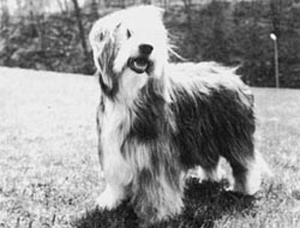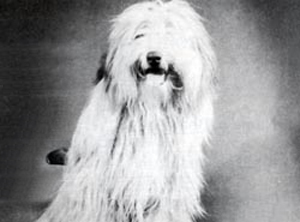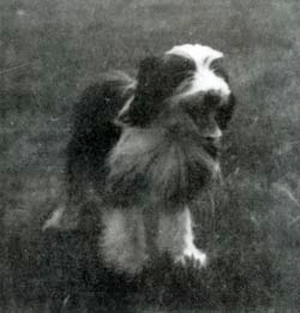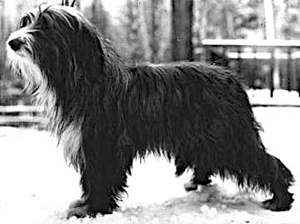
The Bearded Collie in Canada
In her article The Beginnings of the Beardie in Canada Alice Bixler writes:
"While researching material for the 1988 CKC Centennial, I came across an interesting item in the December, 1919, issue of Kennel & Bench magazine, the forerunner of Dogs in Canada. In an article, Dogs of the Empire, the author Freeman Lloyd wrote:
'It would appear that the bearded sheepdogs or shepherd dogs of Scotland were earlier known in Canada than the finer-bred black and tan collies from north of the Tweed. As before written, Scotsmen are great colonists and are wont to travel to the ends of the earth. After settling down, they send to the old land for well-bred horses, cattle, dogs, other animals and birds of the domesticated kinds. About 30 to 40 years ago, there were no other cattle dogs than bearded collies used about at slaughter houses in the east end of Montreal. These dogs were in common use by the French-Canadian drovers. The dogs were blue and blue-grey in colour. They were described to me by Robert Ross of Montreal who knew them well. 'They were just the blue of the Skye Terrier, with a white or pepper-and salt grizzle shade running all through it.' In Britain, such dogs were called Highland Collies.'
That would place Beardies in this country since the 1880's. What happened to those early dogs in unknown. When they were no longer required as drovers, it's likely their numbers dwindled. Certainly there were people who immigrated from England and Scotland who brought their shaggy companions along. But there was no record of their existence, no driving force to unite the breed and put it in the spotlight of public awareness. At least not until Carol Gold."
Major James C. Logan in his article “The Bearded Collie Origins and Early History (appearing in Moorhouse, K. Suzanne. 1990. Talking about ...beardies) "...the leading figure in the breed was Bailie James Dalgliesh. Among his dogs...Ellwyn Ken was exported to Canada in 1913. He was not the first Beardie in that country as the 'Collie Folio' of September 1910 refers to two Beardies being benched at a show in Calgary." These two Beardies are thought to have been exported by a British breeder and enthusiast, Bailie Dalgliesh.
In a more recent history, we had a few Beardies who worked for a living in British Columbia, as described by Jacqueline Byrnes in an article in the Bearded Colleague. Bill Beecher went to Portland in search of an Old English Sheepdog and came home with a six-week old female Beardie, Beauregard, in the fall of 1966. Bill's travels took him to Kamloops where Beauregard began to work in the Kamloops stockyards at the age of 9, never having seen stock before. Her job was to work the cattle sales, taking the animals to and from the scales. She was excellent at loading particularly difficult stock. She would nip the cattle it they proved too difficult but generally shoulder checked or hip checked the stock. Her work was usually with cattle although she did work sheep once. Beauregard was put on the payroll and earned $4 per day. She worked until she was 16 or 17 years old and lived to just short of her 21st birthday. She was a big girl, nearly 22 inches, large, solid, deep chested with lots of bone weighing about seventy pounds.
Carol Gold led the push to bring about public awareness of the Bearded Collie after bringing Wishanger Marsh Pimpernel to Canada in 1968 after living in England for a while. In 1970 the Canadian Kennel Club required only seven dogs for the breed to be recognized (an amazing number when you think about it today!). Carol, with her outgoing and forceful personality, attracted devotees to the breed and by 1970 a national club had been formed and application for recognition was made. The Bearded Collie became a recognized CKC breed on August 19, 1970.
The seven Beardies (referred to as "the Original Seven" or "the Magnificent Seven" ) who paved the way for the rest of our Beardies were:
• Bracky of Bothkennar (arrived 1963) - owner: Muriel Ratner
• Wishanger Marsh Pimpernel (arrived 1968) - owner: Carol Gold
• Osmart Brown Barnaby (arrived 1970) - owner: David & Linda MacLennan
• Osmart Black Cherry (arrived 1970) - owner: Bob & Helen Wilson
• Tarskavaig Black Maria (arrived 1970) - owner: Barbara Blake
• Tarskavaig Black Velvet (arrived 1970) - owner: Alice (Bixler) Clark
• Cynpeg’s Hillbilly (arrived 1970) - owner: Alice (Bixler) Clark
 Bracky of Bothkennar |
 Wishanger Marsh Pimpernel |
 Osmart Brown Barnaby |
 Osmart Black Cherry |
 Tarskavaig Black Maria |
Unfortunately, a photo of Tarskavaig Black Velvet |
That is not to say that in 1970 there were only seven Beardies in Canada - there were more. Alice Bixler had a girl, Hermione, who had been bred in the USA. As the AKC did not recognize Beardies at that time, she was not eligible for CKC registration. The first Canadian bred litter of Beardies was whelped (by Wishanger Marsh Pimpernel bred to Osmart Brown Barnaby) in July 1970 and became the first litter registered in Canada. Alice imported Bronze Javelin of Tambora and Audrey Benbow and Audrey Gray imported Broadholme Cindy Sue of Willowmead. During those early years a number of Beardies were imported from the UK in addition to the litters produced in Canada, thereby increasing the Beardie population.
By late 1970, there were 24 Beardies known to be in Canada (12 in Toronto, 4 in Montreal, 3 in the Hamilton area, 2 in Calgary and one each in Trenton, Waterloo and Regina). This is compared to a year earlier when there were only 4 in the entire country! By late 1971 there were 50 - obviously the Beardie bounce was winning hearts in Canada!
In a March 2009 report, the Canadian Kennel Club showed that, in 2008, 21 litters were registered and 100 individual dogs registered, compared to 18 litters and 142 individual dogs in 2007. These numbers have been relatively consistent for a few years now.
For a more detailed look at the history of Bearded Collie in Canada, the reader is referred to the following articles:
• The Beginnings of the Beardie in Canada
• Early Days in Beardies
• I Remember the Very First Beardie
• The Bearded Collie Club of Canada is 25 Years Old... A Look Back
Copyright © 2009 [Lois Gaspar]
All rights reserved.
